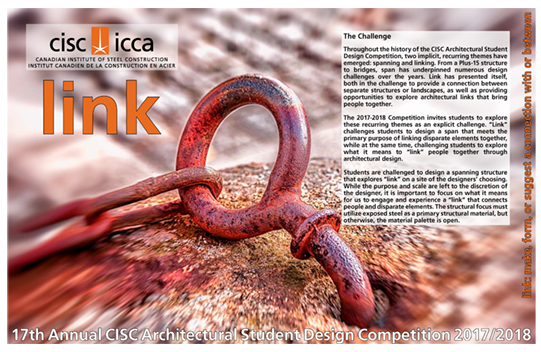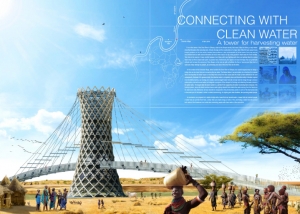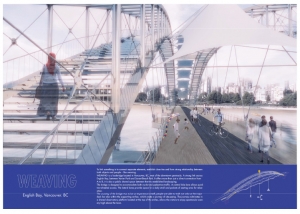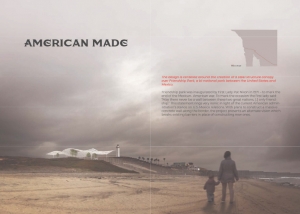2017- 2018

Finalists
Project Title | Student(s) | University | Faculty Sponsor(s) | Award |
| Connecting with Clean Water | Salim El Filali & Amirhesam Monshi | University of Waterloo | Terri Meyer Boake | Award of Excellence |
| Weaving | Ruotao Wang & Shengyu Cai | Ryerson University | Vincent Hui | Award of Merit |
| American Made | Alexey Vasiliev & Marco Adly | University of Waterloo | Terri Meyer Boake & Michael Maciej Bartosik | Award of Merit |
| Thermal Bridge | Alexander Caskey | Dalhousie University | Talbot Sweetapple | Finalist |
| I feel like we’re drifting apart | Elise Cloutier & Jacob Dimla | University of Waterloo | Terri Meyer Boake | Finalist |
| Auxilium | Heng Sheng Cai & Cian Hrabi | University of Waterloo | Terri Meyer Boake | Finalist |
| Riding the Wave | Annie Wang | Benjamin Hao | Terri Meyer Boake & Michael Maciej Bartosik | Finalist |
| Horizon Bridge | Luke Kimmerer | University of Waterloo | Terri Meyer Boake | Finalist |
| Oasis | Riling Cheng & Tomoki Kaneko | University of Waterloo | Terri Meyer Boake & Michael Maciej Bartosik | Finalist |
| PARALLELS | Aurora Chi & Magnus Glennie | University of Waterloo | Terri Meyer Boake | Finalist |
Thank you to this year’s judges:
Paul Laurendeau, Architect, Atelier Paul Laurendeau
Kristof Janukiewicz, Senior BIM Modeler, Walters Inc.
Bechara Helal, Architecture Assistant Professor, Université de Montréal
Michel Comeau, Senior Structural Engineering, Campbell Comeau Engineering
The Challenge
Throughout the history of the CISC Architectural Student Design Competition, two implicit, recurring themes have emerged: spanning and linking. From a Plus-15 structure to bridges, span has underpinned numerous design challenges over the years. Link has presented itself, both in the challenge to provide a connection between separate structures or landscapes, as well as providing opportunities to explore architectural links that bring people together.
The 2017-2018 Competition invites students to explore these recurring themes as an explicit challenge. “Link” challenges students to design a span that meets the primary purpose of linking disparate elements together, while at the same time, challenging students to explore what it means to “link” people together through architectural design.
Students are challenged to design a spanning structure that explores “link” on a site of the designers’ choosing. While the purpose and scale are left to the discretion of the designer, it is important to focus on what it means for us to engage and experience a “link” that connects people and disparate elements. The structural focus must utilize exposed steel as a primary structural material, but otherwise, the material palette is open.
Competition Statement
The intention of this design competition is primarily to provide students of architecture in Canada with a unique opportunity: to enter into a design process that brings together, of necessity, concept and reality. It is important for students of architecture to grasp the fact that structural design lies not just in the realm of the engineer, but can be a means for architects of arriving at a meaningful realization of architectural ideas. It is when theory meets physical necessity that architecture can become really interesting.
To that end, this competition calls upon students to conceptualize, and realize in detail, a structure of simple program that explores the meaning of link. The exploration will, of course, include issues related to program and site, but the emphasis in this competition is upon the architectural exploration through form and material, on the essential relationship between architecture and structure.
The reality of this competition comes in two forms: through the requirement for buildable details, primarily utilizing structural steel; and through the collaboration with the steel fabrication industry on those details. This collaboration is an important component of this competition, as a secondary objective is to expose students to both the opportunities and restraints inherent in realizing conceptual design.
The conceptual component of this competition will come through the recommendation that this competition be run through either a studio, or a lecture based course, most probably within a structures course. Under the guidance of faculty sponsors, students will conduct the design process as an academic exercise, within the guidelines set out in this brief. As an academic project, the design process will adhere to the standards set forth by the students’ school of architecture.



